A short stroll on Bonnet Street
By Anita Rafael
Photography By Timothy Peters
Here is a wonderful walk to take in Manchester Center— something to enjoy after your shopping and your gallery hopping, after you are done exploring along the Riverwalk at the Town Green, and after you have had a bite to eat in town. This is a short, self-guided stroll on Bonnet Street, the perfect block or two to see what adds to Manchester’s charm.
In hundreds of towns throughout New England, the earliest churches were erected at the edges of measured and typically rectangular town commons, or village greens. Here, the Gothic revival-style First Baptist Church, 1833, and with additions from 1870, overlooks one of the busiest intersections in town. If you can picture a dozen or more mills and manufacturers within a couple of blocks of the church, with their hundreds of workers, their daily deliveries of raw materials inbound and their shipments of finished goods out-bound, someone or something always coming and going, plus nearby inns, taverns, shops, and banks, then you can imagine that this corner would have been as full of activity then as it is now.
Begin this walking tour at the intersection of Main Street and Bonnet Street at the First Baptist Church. Walk along the right-hand side (eastern side) of the street.
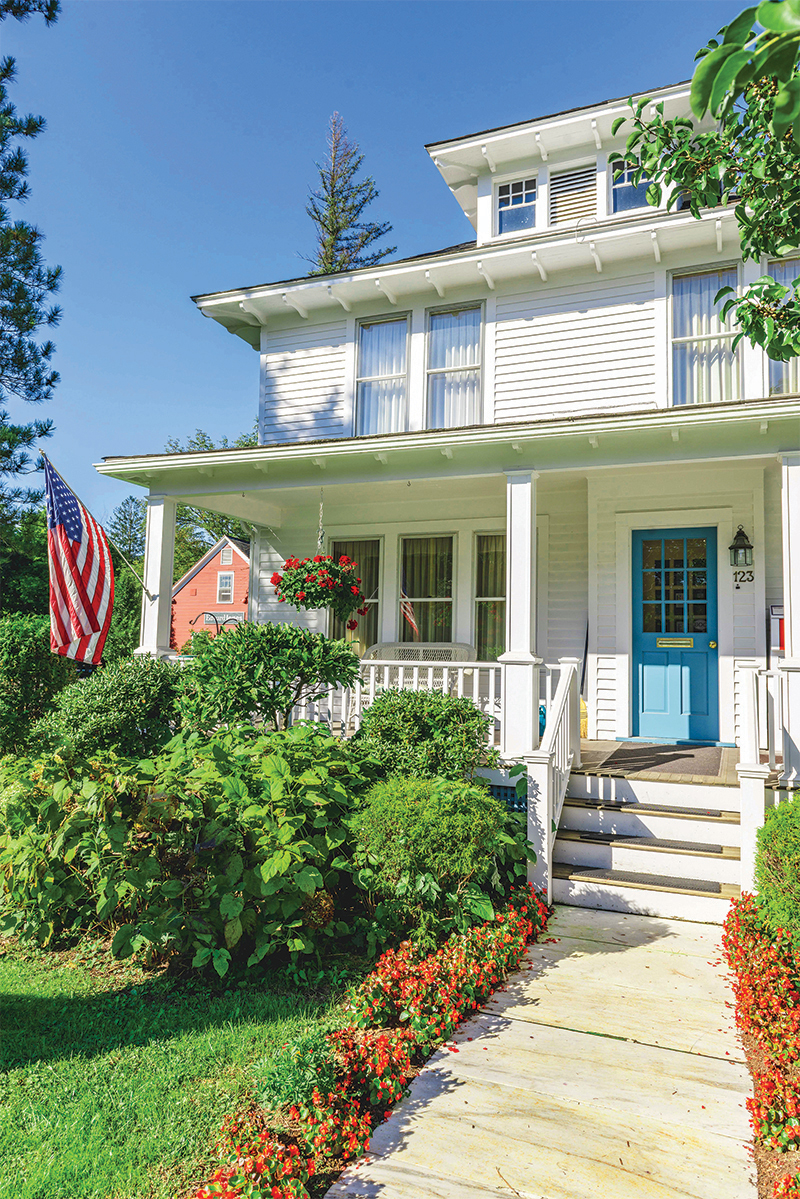
Bonnet Street is a good example of how a town grows and changes over time. After you have walked a short distance past the church and the new Manchester Medical Center, stretch out your right arm sideways and point—had you done that a century ago, you would have been looking out across many acres of open farmland down to the banks of the Batten Kill, the trout-famous river that winds through town. Early maps show no houses on the northbound (eastern) side of the street, while on the opposite side, the buildings appear close together on small lots. Before this side of the street was built up beginning in the 1880s, you would have had a clear view of the bucolic countryside, with glimpses of the river, too, and livestock grazing in the far-off pastures.
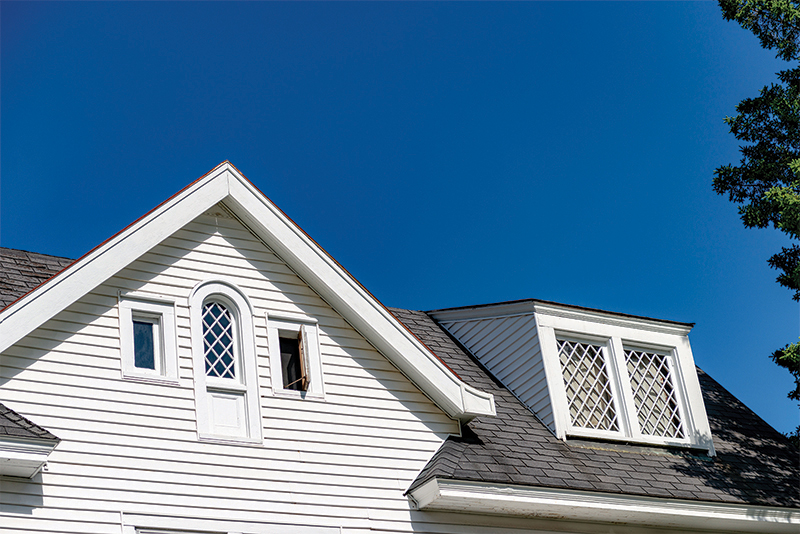
As you walk along, train your eye to dance around the details on every building, taking in the most diminutive as well as the most dominant features. Sometimes the appeal of a façade is the way an entrance is framed, recessed, or askew; sometimes it is the way a veranda is wrapped just so; sometimes it is just the pitch and outline of a roof: hip, gambrel, or gable. For example, on the roof of 78 Bonnet Street, a house built circa 1910 called The Sandtrap, look up at the subtle flare on either end of the large front gable. The merest curve, kicked up a tad like the corners of a smile. The eave of the main roofline makes a deep return below the gable on either end, too, redefining the big triangle even more. Once you begin to notice them, these are the kind of understated details that delight the eye. The upper story of the house would seem unbalanced without the visual anchor of the broad and inviting porch with its big double columns and wide steps at the ground level. “This was the period of porches,” Manchester architect and preservationist Bill Badger reminds us, agreeing that these houses were built to impress.
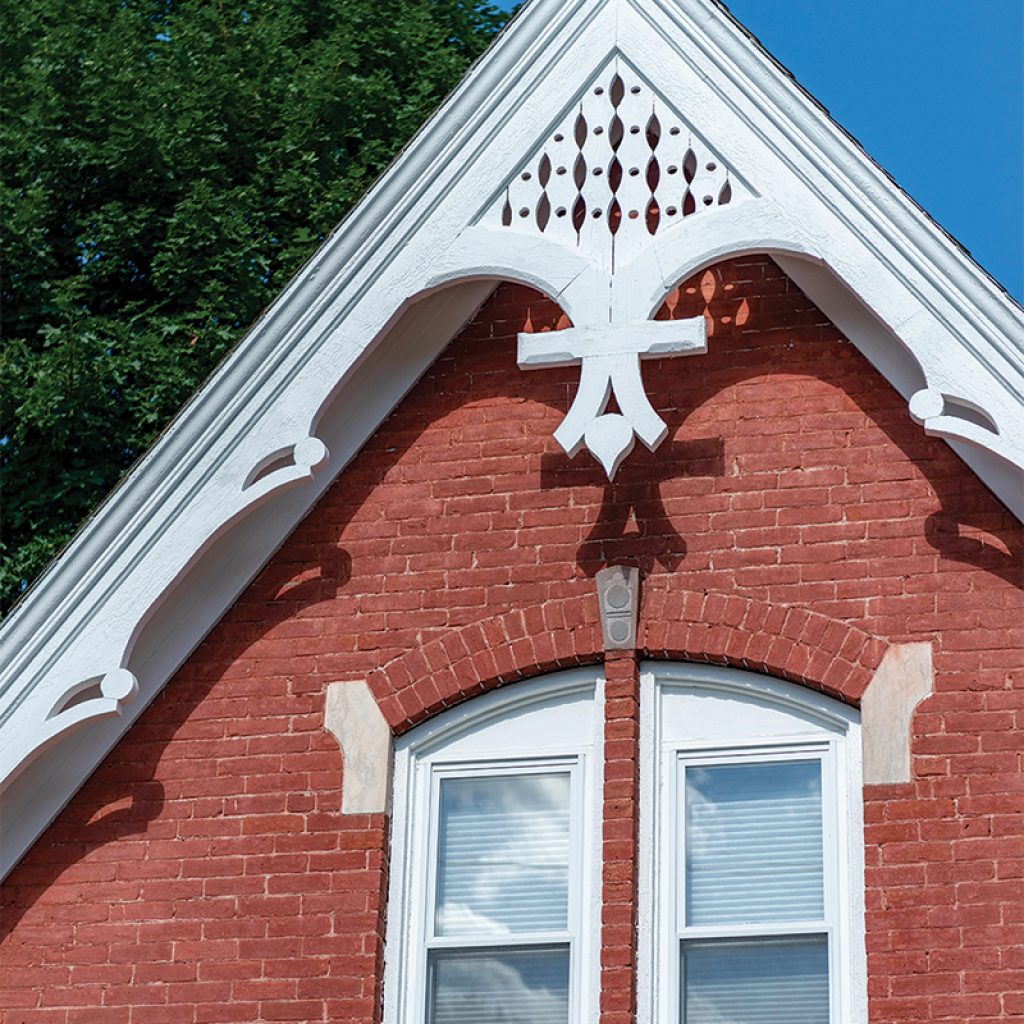
Street.
The next house on Bonnet Street is the rectory of the First Baptist Church, circa 1890s. This is what people mean when they say a Victorian house is “Carpenter Gothic.” Did you just whisper the word “gingerbread” to yourself ? It is an informal term for this style, which hints at the way picturesque folk dwellings were adorned. Using manuals with detailed plans and elevations showing countless elements of design, builders were free to choose, or to let their clients choose, from a cornucopia of construction curiosities. Remember one thing as you study the intricate sawn, drilled, and carved decorations: in this era, builders had steam-driven power tools, making it quicker and more efficient to create matching bargeboards, brackets, balustrades, and what-have-yous. The brickwork, the marbles, the wooden decorations, and the hooked-on roof slates are a wonderful combination of organic materials. Describing the house at 136 Bonnet Street, Badger says, “This is a classic Colonial revival-style with a bit of Queen Anne thrown in to account for the irregularity.”
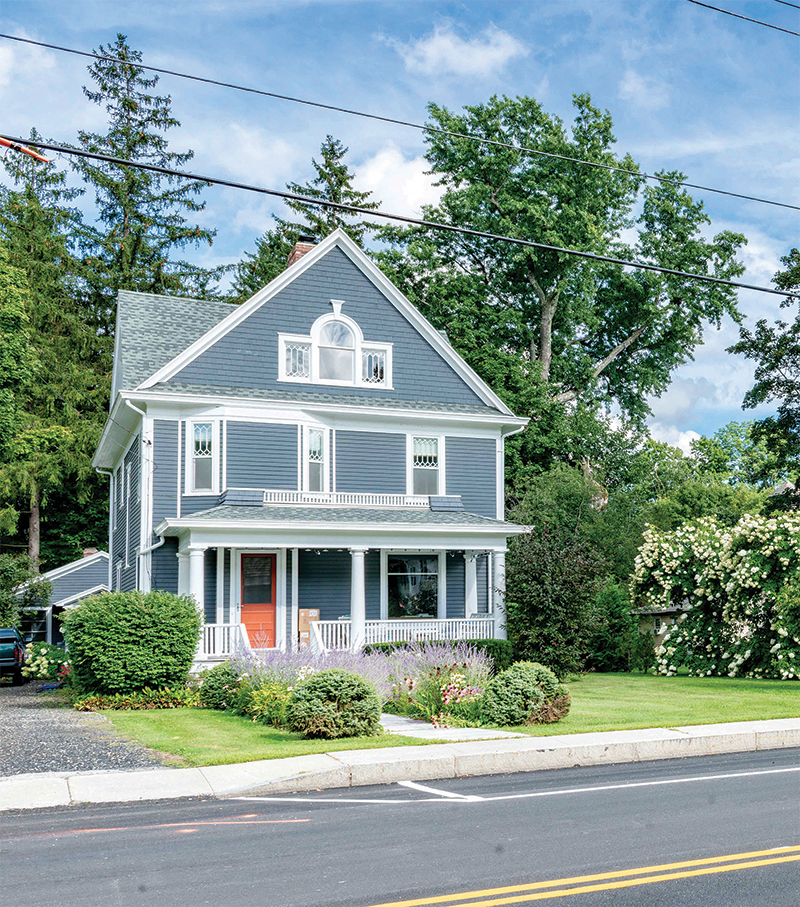
Having admired the bold beauty of this house, built around 1920, perhaps you would like to know what it is like to live in downtown Manchester. Homeowner Joanie Pine Burns, who did a major restoration seven years ago, says, “I love it. I wanted very much to be right in town. Bonnet Street is not as busy as Main Street where there are more businesses and tourists, and in the evenings, it quiets down here. I often walk and chat with my neighbors, and it’s quite nice to hear stories about their houses.” She says her house, which she calls Bonnet House, has “a great spirit.” You, too, can give daily life on Bonnet Street a try—Burns lists the cute cottage (originally a two-car garage) tucked in beside the house as a short-term rental called Tucked In.
Stop a moment to shift your gaze along the row of buildings across the street—you will notice that many of the properties have undergone what city planners call “adaptive re-use.” It is a formal way of saying “We took an old building and made something else out of it without tearing it down.” The challenge is to look past the signage and through the new, and sometimes, odd additions to “see” the original structures. Bonnet Street has benefited immensely from the ways in which people modified some of the older homes and small home-businesses into retail shops and professional offices. “People don’t realize,” Badger says, “that once places like this are gone, they’re gone forever.”
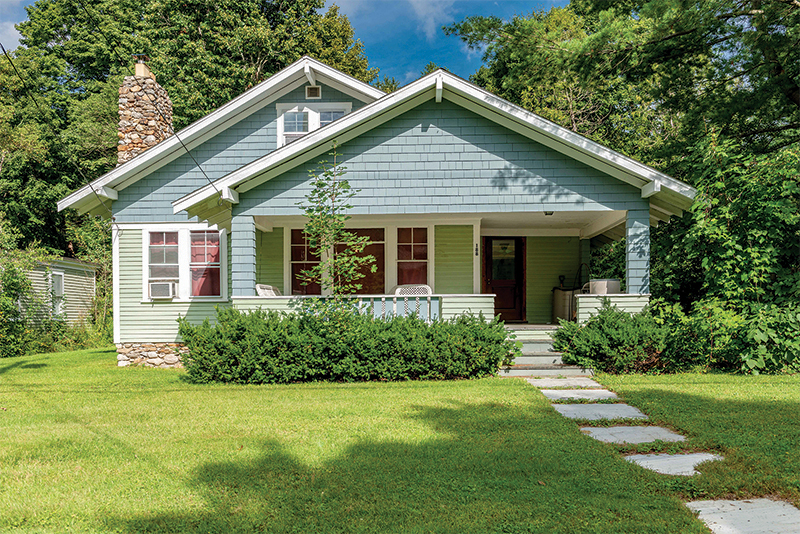
As soon as you see a lot of heavy bracketing under the eaves on a house, such as at 152 Bonnet Street (dating from the 1880s), you may say it has Italianate features. Next, look for the modern” house at 188 Bonnet Street. Known as the Woodcock House, it dates to 1920. Its size, scale, and shape are unlike any other dwelling on the street, and it succeeds in adding that much more character to the neighborhood as a whole. The layered, low rooflines, exposed rafter ends, and the tapered fieldstone fireplace are typical bungalow elements. “I like it,” says Badger. “I like the colors they’ve given it, and see? There is some stained glass visible through the front door and leaded glass above the plate window in front.
It is worth noting that the Bonnet Street homes were year round residences according to Shawn Harrington, curator at the Manchester Historical Society. Keep walking slowly along Bonnet Street, be curious, and soon you will find that your quiet eye will linger over each of the fine details on house after house.
When you reach Two Cow Lane on your right-hand side, cross to the opposite side of Bonnet Street. Be cautious and watch for traffic. To continue the tour, head back to where you began (along the western side of the street).
Now that you have practiced the sport of spotting architectural features, the game gets a little more difficult on this side of Bonnet Street where most of the structures are earlier and have undergone many changes over time. Still, there are many interesting things to see. Not to be forgotten—the setting. Look up at the ridgeline of the mountains in the distance. As you walk along, you can also see mountaintop vignettes toward the west by peeking in between the houses.
Here is a checklist of a few elements to pick out and ponder along this side of Bonnet Street:
✓ At 231, now offices, notice the unusually long windows, reaching almost to the foundation, and the 4-over-6 arrangement of the panes. It is an early structure, perhaps 1840s, and this was one of the bonnet “factories”—Fannie C. Blackmer’s place. She advertised “Nice Velvet Hats $2 to $3.”
✓ At 187, a house from the 1880s, there is an abundance of Victorian-era detail, enhanced to perfection by a polychrome paint job just last summer. A very decorative surround on the door! Here is a question Bill Badger posed about this house: was there a narrow porch at one time all across the front connecting the two side porches? (Old photos prove he is correct.)
✓ One of the oldest commercial locations in continuous use on the street is the building at 147, now P & F Appliances. The 1860s furniture store here, D.S. Wilson’s, also sold picture frames. Coffins and caskets, too. ✓ Stop to study the house at 123, now Kittredge Insurance Corporation. Look very closely. Can you tell that this is a 1918 catalog house? (Possibly Sears.) It is referred to as American Foursquare style, popular and so fashionable at the time. Largely unaltered on the street side over the past century, it was assembled from a pre-cut kit that came into town on the train. Become aware of the three-part harmony of the hipped roof, the hipped porch roof, and up top, the hipped dormer. The rear addition is from 1930.
✓ The plain Greek revival-style house, circa 1850, at 105 is an example of a property where almost all of the architectural interest is on the neoclassical door surround and a recessed entryway with narrow sidelights.
✓ The wonderfully restored Colonial revival-style house at 75 Bonnet
Street, built in the 1890s, is truly a jewel. Stop to admire the interesting variations on gables on the façade and both sides. Notice the tiny panes of glass, and how they add visual interest to the façade.
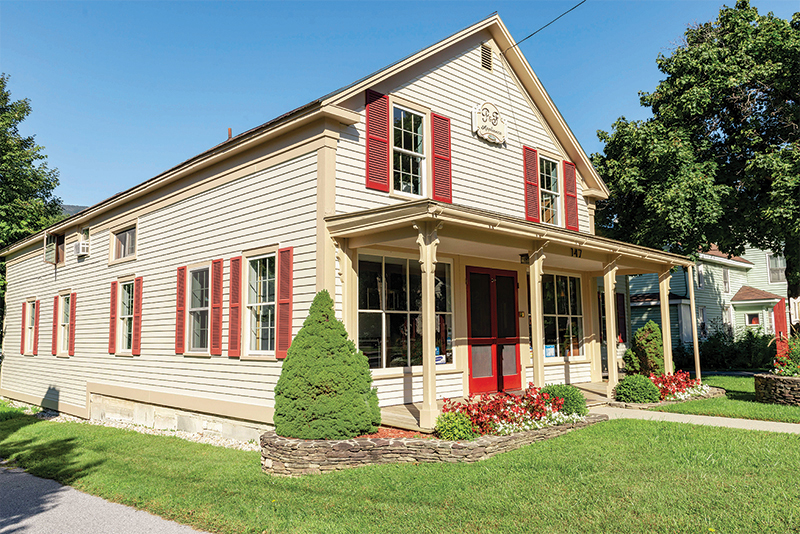
Northshire Bookstore at the corner of Bonnet and Main is a good place to finish your brief adventure. It is well worth taking the time to browse the local history shelves, the new books as well as the reprints of historic volumes. “I think the architecture of Bonnet Street is representative of a reasonably prosperous town of a certain time,” says Badger. “You see similar streetscapes near the heart of many well-to-do small towns. Places like this make me ask, ‘What went on here?’ With tourism, Manchester stayed prosperous because of the summer people, and in the mid- 20th century, the ski industry, so the buildings have been kept up for the most part.” What prevented Bonnet Street from becoming just another “strip” on the road out of town was early zoning ordinances that allowed, and even
encouraged re-use. Buildings can always find more uses, Badger says, and nothing is frozen in time.
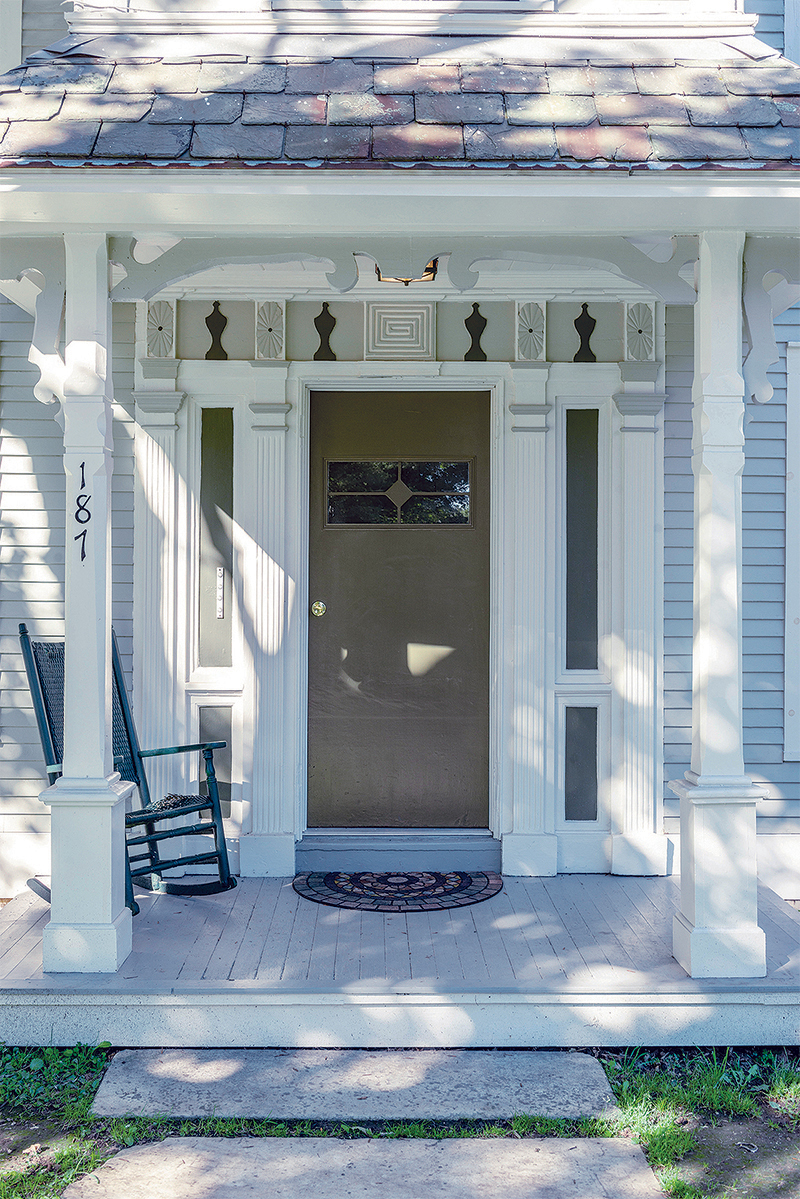
With special thanks to Shawn Harrington, curator, Manchester Historical Society. The mission of MHS is to collect, preserve, interpret, and present the story of Manchester, Vermont. The archive is located in the Manchester Community Library, 138 Cemetery Avenue, Manchester Center. 802-549-4582 or manchesterhistoricalsocietyvt.org
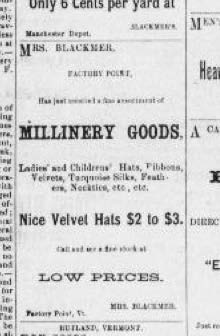
Journal, October 28, 1875
why “bonnet” street?
On the oft-cited 1869 F.W. Beer’s map this is called North Street; it was changed to Bonnet Street in the 1920s. When this area was first settled, this was farmland owned by Gilman Wilson, and it was a part of town called Factory Point (later renamed Manchester Center). Bonnet Street was a node of industry with small-scale, home-based businesses. No guessing is required here— it is called Bonnet Street because, as the author Mary Hard Bort, in her book Manchester— Memories of a Mountain Valley tells us, there were three milliners on the street at the end of the 19th century, plus one hat maker, Carson Meacham. The milliners were Minnie Cook, Clara Hannaman, and Fanny Collins Blackmer. In addition to bonnets, the milliners made and embellished all manner of fine accessories with fancy feathers, artificial flowers, ribbons, and beadwork for fashionable women.
The presence of the milliners, a hatter, an early furniture store, many small enterprises and professional offices, and even apartments, suggests that by 1900 things were transitioning in Manchester from labor-intensive manufacturing to a more genteel kind of commerce, not unlike what you see here today. In 1985, Bonnet Street was listed on the Vermont Register of Historic Places.
–A.R .